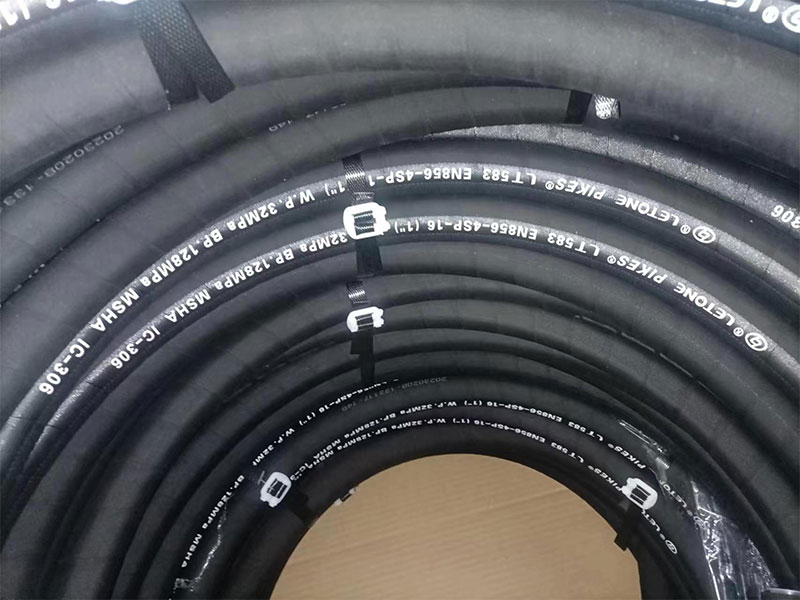In the fields of modern architecture, industrial production, and infrastructure construction, material transportation plays a crucial role. Especially in the transportation process of materials such as concrete, sand and gravel, cement slurry, gypsum, etc., conveying hoses are widely used due to their unique advantages. This article will provide a detailed discussion on this type of material conveying hose, including its structure, characteristics, application areas, and maintenance, in order to provide valuable reference for relevant practitioners.
1、 Structure and characteristics of material conveying hoses
Material conveying hoses are usually composed of inner and outer rubber layers, reinforcement layers, and protective layers. The inner and outer rubber layers are responsible for the sealing and wear resistance of materials, and are usually made of synthetic rubber materials that are highly wear-resistant, oil resistant, and corrosion-resistant. The reinforcement layer is the skeleton of the hose, which plays a role in bearing pressure, tension, and torque. It is generally woven from high-strength fibers or steel wires. The protective layer is used to protect the hose from external damage, such as ultraviolet radiation, mechanical wear, etc.
Material conveying hoses have the following characteristics:
1. Good flexibility: The hose has good bending performance and can adapt to various complex terrains and installation needs of equipment.
2. Strong wear resistance: The inner and outer rubber layers are made of highly wear-resistant materials, effectively extending the service life of the hose.
3. Corrosion resistance: It can resist the erosion of various chemical substances, ensuring the safety of materials during transportation.
4. High pressure bearing: The design of the reinforcement layer enables the hose to withstand high working pressure, meeting the needs of various working conditions.
5. Easy installation: The hose is lightweight and easy to operate, allowing for quick installation and disassembly, reducing labor intensity.
2、 Application fields of material conveying hoses
Material conveying hoses have a wide range of applications in fields such as construction, industrial production, and infrastructure construction. Specifically, it can be used in the following scenarios:
1. Construction industry: In situations such as concrete pumping and gypsum board production lines, material conveying hoses can be connected to pumping equipment and pouring points to achieve efficient and safe material conveying.
2. Industrial production: In industries such as mining, metallurgy, and chemical engineering, material conveying hoses can be used to transport various bulk materials, powdered materials, and liquid materials, such as sand and gravel, cement, mineral powder, etc.
3. Infrastructure construction: In projects such as bridges, tunnels, and highways, material conveying hoses can be used to transport building materials such as concrete and cement slurry, ensuring the smooth progress of the project.
3、 Maintenance and upkeep of material conveying hoses
To ensure the normal use of material conveying hoses and extend their service life, regular maintenance and upkeep are necessary. Here are some suggestions:
1. Regular inspection: Regularly inspect the appearance of the hose to see if there are any abnormal conditions such as wear, cracks, deformation, etc. If found, it should be replaced or repaired in a timely manner.
2. Cleaning and maintenance: After use, the hose should be cleaned to remove residual materials and dirt. At the same time, the hose should be avoided from being exposed to sunlight, heat sources, or chemicals for a long time to avoid accelerating its aging.
3. Storage management: When storing hoses, they should be avoided from folding, twisting, or being compressed to prevent damage to their structure. Meanwhile, it should be stored in a dry, ventilated, and cool place, avoiding direct sunlight and moisture.
4. Operating standards: When using hoses, the operating procedures should be followed to avoid overloading, overspeeding, excessive bending, and other operations to prevent damage to the hoses.
4、 The development trend of material conveying hoses
With the continuous advancement of technology and the increasing demand for environmental protection, material conveying hoses are also constantly developing. In the future, material conveying hoses will pay more attention to environmental protection, energy conservation, and intelligence. Specifically, future material conveying hoses may be made of more environmentally friendly materials to reduce environmental pollution during production and use; Meanwhile, by optimizing the design and improving the process, the wear resistance, corrosion resistance, and service life of the hose can be enhanced; In addition, the application of intelligent technology will also enable material conveying hoses to have a higher degree of automation and higher safety performance.
In short, material conveying hoses play an important role in fields such as construction, industrial production, and infrastructure construction. By understanding and mastering its structure, characteristics, application areas, and maintenance, we can better utilize this efficient material conveying tool and make greater contributions to the development of related industries.

